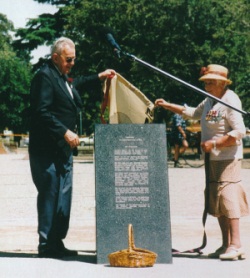 Maxwell R. Hayes
Maxwell R. Hayes
R.A.A.F. R.P.N.G.C. P.N.G.V.R.
The commemoration of the $1,800,000 130 metre polished black granite wall at the Ballarat Botanical Gardens to honour and name the 35,675 Australian Prisoners of War (POW) from the Boer War and subsequent wars until the Korean War 1950-53 took place on Friday 6th February 2004.
The POW wall commemoration was a much publicised event with our Governor General, Major General Michael Jeffery, General Cosgrove, the Victorian Premier and other dignitaries taking a prominent part in the proceedings to commemorate our POW until the Korean War concluded in 1953 (there were no POW in Vietnam or subsequently). This event was very well covered by all national and regional newspapers and TV stations. Some 8000 including about 500 surviving POW attended this event.
By contrast, whilst the City of Ballarat, as sponsor for the commemorations, worked hard locally to make the events of Friday and Saturday a success, it was almost impossible to achieve any publicity for the Montevideo Maru commemoration on Saturday 7th February. I personally contacted ABC Radio, ABC TV and Melbourne newspapers – none sought fit to refer to this event, save by obscure oblique references relating to the ship, and none advised of the Saturday commemoration, making this event virtually a secret rivalling some of the best Second World War secrets. Why??
Prior word of mouth and phone calls by those interested did, however, attract some 400 people to this event on a beautiful day; and some seating was provided, though seating and tents etc from the previous day’s commemoration, were being noisily knocked down and carted away during the ceremony. Mr Kim Beazley MP was in attendance, having a personal interest in the loss of his uncle, a missionary carpenter, who did not survive.
It was pleasing to see the Veterans’ Band of The Salvation Army in attendance and their performance was much appreciated. It was the Brunswick Salvation Army Band which volunteered in 1941, en masse, to join the 2/22nd and all were lost, save for one, in the Rabaul events.
Presiding Officer for the Ceremony was Brigadier Keith Rossi (retd), AM, OBE, RFD, ED. After introductory welcomes by the Mayor of Ballarat and the Project Officer of the Memorial; Mr Norman Furness, President of the 2/22nd Battalion Lark Force Assoc (one of those to escape Rabaul after the Japanese invasion of 23-1-1942) and Mr John Clark, representing relatives of those who died on the Montevideo Maru, Mr Ian Hodges of the Australian War Memorial, and Mrs Margaret Reeson delivered summary and background commentaries.
| It then fell to Mrs Lorna Johnston, Mentioned in Despatches (MID) (nee Whyte), who came from New Zealand for the event, formerly of the Australian Army Nursing Service and who was captured in Rabaul and transported to Japan as a POW on the Naruto Maru where she remained for three years until the end of the war, to address those present and unveil the polished black granite monument, which is situated adjacent to the centre of the long POW wall.
Today there are only three of the nurses who were taken to Japan alive (one Army, one Missionary and one civilian). It seems appalling to me that the best recognition which can be offered this brave woman was a MID. Following this, the dedication of the monument was lead by Canon John May, MBE, who was Padre of the 2/22nd Battalion, and also captured and taken to Japan along with the captured nurses and the army officers on the Naruto Maru and who all survived the war. Wreaths were then laid by several persons on behalf of the fallen and poppies laid in personal remembrance by hundreds at the monument. This monument is largely the inspiration of Dr Les Drew of Canberra, in memory of his older brother, a member of the Salvation Army Band. Subsequently is was noticed that several service units, captured or who died in the defence of Rabaul had been accidentally omitted in the engraving on the granite face and a new granite slab approximately 50mm thick was added to the monument face. This gave recognition to the 1st Independent Company, Fortress Engineers, Signals, Artillery, No 17 Dental unit, Ordinance Corps, Division Supply Column, Canteen Services, the Royal Australian Navy, and the Salvation Army Band. It seems that the crew of the Norwegian “Herstein”, bombed and sunk at Rabaul three days after the fall of Rabaul on 23rd Jan uary 1942, have not yet been added. Had there not have been a decision made by the Curtain Government to not evacuate those captured in hopelessly indefensible Rabaul it is almost certain that there would have been no loss of life on the “Montevideo Maru” The following is the wording on the Ballarat Memorial: MEMORIAL TO THOSE WHO DIED ON THE MONTEVIDEO MARU On the 23rd January 1942 the Japanese invaded Rabaul, on the island of New Britain, and quickly defeated the small Australian garrison – LARK Force. About 160 of the Australian soldiers who surrendered were massacred in February, at Tol Plantation. On the 22nd June 1942, the Japanese ordered 845 Australian POW’s and 206 civilian internees to board the Japanese ship Montevideo Maru, for transport to Japan. The ship bore no markings to indicate that it carried POW’s. The POW’s were members of the 2/22nd Battalion AIF, New Guinea Volunteer Rifles, an anti-tank battery, an anti-aircraft battery, a coastal defence battery, a RAAF group and a detachment of the 2/10th Field Ambulance, uniquely the 2/22nd Band were all members of the Salvation Army bands. On the 1st July 1942, An American submarine the USS Sturgeon, attacked and sank the Montevideo Maru unaware that more than 1000 POW’s were locked in its holds. There were no survivors – no indication of its sinking nor of the tragic loss of life was given by the Japanese Government. The sinking of the Montevideo Maru is the largest wartime disaster in Australian history. |
